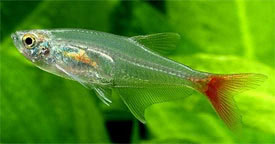Prionobrama filigera - Glass bloodfish, Glass bloodfin
 Magyarul / Hungarian
Magyarul / Hungarian

 Magyarul / Hungarian
Magyarul / Hungarian


- Scientific name: Prionobrama filigera
- Common name: Glass bloodfish, Glass bloodfin
- Group: Characins
- Habitat: South America; Southern Brazil and Argentina, Rio Paraguay.
- Size: 6 cm
- Biotope: slow moving waters
- Social behavior: Peaceful, but shy .Swims under the surface.
- Diet: All food is accepted
- Breeding: Quite easy.
- Tank: Minimum 120 litres
- Population: 8-10 fish for 120 litres
- Decoration: Plants and stones, floating plants to provide protection from above<
- Temperature: 22-28°C
- pH: 7-7,6.
- Hardness: 6,7-11 NK°
- Lifespan: 10-12 years
The male is smaller and slimer than the female. Also, the female is bigger and rounder and she may have larger first anal fin with white beams.
The Glass bloodfin species likes every kind of food. Live, frozen, dried. We feed them flakes, which they like to eat from the surface together with Black skirt tetras. They look like little piranas. But don´t think I don´t feed them often, I am feeding them two times a day, so they aren´t hungry. When we started with bloodfins, they did not take their food from the surface and they only ate food from the water. We give them granulated food and frozen food too. Bloodworms are guaranteed success.
This tetra prefers breeding in the morning hours, when the aquarium is lighted with sun and when they are in shoal, not in couple. The breeding tank shouldn´t be small, maybe 30x30x80 cm is optimal. Spawning happens under the water over or in the soft aquarium plants like java moss or even between green silicone silk. During one spawn they can lay up to 200 or even 350 eggs. The eggs are clear and not very adhesive, only few stay stuck to the spawning place. The eggs usually fall down to the substrate. They eggs are about 0,90 mm long and they hatch by the temperature 27°C very soon, even after 14 - 15 hours and little fry are about 2,25 mm long. They detach sticky secretion on their heads and they try to stuck to the walls of the aquarium or on the plants on shaded places. Sometimes they stuck to the water surface. In the age of 84 or 85 hours they swim free. From this time you have to feed them with live nature food, or just hatched sea monkeys. The breeding behaviour is similar to the breeding behaviour of the Aphyocharax anisitsi and rathbuni species. They creep on the plants, aquarium glass or aquarium equipment with the bellies up side down. But they grow faster than anisitsi and ratgbuni. When they are 7 to 8 weaks old, they start to swim just like their parents in shoals in the whole aquarium. In this age they can be fed crushed TetraMin for instance. With good food they grow up after 4 to 8 months. If they get less food, they grow up after 8 to 10 months. You should take care, if they have crystal clean water, the water should not contain much nitrogenous and the pH should be about 7 to 7.8, all the time while the little things are juveniles.
Hasonló vízparamétereket igénylő fajok























